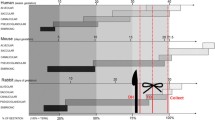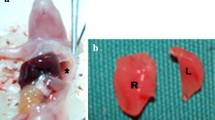Abstract
In congenital diaphragmatic hernia (CDH), both mortality and morbidity are mainly caused by pulmonary hypoplasia and persistent pulmonary hypertension. Insulin-like growth factors (IGFs) are one of the growth factors that may play an important role in the fetal lung development. Elucidating the roles of these growth factors regarding fetal lung development would thus provide new insight regarding the optimal therapy for CDH patients. The aim of this study is to investigate the role of IGFs in the fetal lung development. The mRNA expression of IGFs and its receptors was analyzed by real-time RT-PCR from embryonic day (E) 11.5 to E18.5 mice. In addition, the lungs dissected from the E17.5 mice were divided into the following three groups; lungs cultured only in the serum-free medium (group I n = 5), lungs cultured in medium containing either IGF-I (group II n = 5), or IGF-II (group III n = 5). All cultures were investigated by immunohistochemistry, using the antibodies of thyroid transcription factor (TTF)-1, prosurfactant protein (proSp)-C, alpha smooth muscle actin (α-SMA), and anti-proliferating cell nuclear antigen (PCNA). The mRNA expression level of both IGF-I and IGF-II was higher during the earlier stage than that of later stage. In contrast, the mRNA expression of both IGF-I receptor (IGF-IR) and IGF-II receptor (IGF-IIR) was higher from the E17.5 to E18.5 than that at any other stage. The number of positive cells for TTF-1, proSp-C, α-SMA and PCNA increased more in both groups II and III than in group I. Based on our findings, IGFs are suggested to induce alveolar and vascular maturation in the late stages of fetal lung development. Therefore, the administration of IGFs to the fetal CDH lung may thus be able to effectively improve the symptoms of hypoplastic lung.





Similar content being viewed by others
References
Suita S, Taguchi T, Yamanouchi T et al (1999) Fetal stabilization of antenatally diagnosed diaphragmatic hernia. J Pediatr Surg 34:1652–1657
BaGolan P, Casaccia G, Crescenzi F, Nahom A, Trucchi A, Giorlandino C (2004) Impact of a current treatment protocol on outcome of high-risk congenital diaphragmatic hernia. J Pediatr Surg 39:313–318
Lally KP (2002) Congenital diaphragmatic hernia. Curr Opin Pediatr 14:486–490
Harrison MR, Adzick NS, Estes JM, Howell LJ (1994) A prospective study of the outcome for fetuses with diaphragmatic hernia. JAMA 271:382–384
Warburton D, Schwarz M, Tefft D, FloresDelgado G, Anderson KD, Cardoso WV (2000) The molecular basis of lung morphogenesis. Mech Dev 92:55–81
Retsch-Bogart GZ, Moats-Staats BM, Howard K, D’Ercole AJ, Stiles AD (1996) Cellular localization of messenger RNAs for insulin-like growth factors (IGFs), their receptors and binding proteins during fetal rat lung development. Am J Respir Cell Mol Biol 14:61–69
Miyazaki E, Ohshiro K, Taira Y, Puri P (1998) Altered insulin-like growth factor I mRNA expression in human hypoplastic lung in congenital diaphragmatic hernia. J Pediatr Surg 33:1476–1479
Oue T, Taira Y, Shima H, Miyazaki E, Puri P (1999) Effect of antenatal glucocorticoid administration on insulin-like growth factor I and II levels in hypoplastic lung in nitrofen-induced congenital diaphragmatic hernia in rats. Pediatr Surg Int 15:175–179
Bjorn Frenckner, Ann-Christine Eklof, Hakan Eriksson, Britt Masironi, Lena Sahlin (2005) Insulinlike growth factor I gene expression is increased in the fetal lung after tracheal ligation. J Pediatr Surg 40:457–463
Pichel JG, Fernandez-Moreno C, Vicarino-Abejon C, Testillano PS, Patterson PH, De Pablo F (2003) Developmental cooperation of leukemia inhibitory factor and insulin-like growth factor I in mice is tissue-specific and essential for lung maturation involving the transcripation factors Sp3 and TTF-1. Mech Dev 120:349–361
Moreno-Barriuso, Lopez-Malpartida AV, De Pablo F, Pichel JG (2006) Alterations in alveolar epithelium differentiation and vasculogenesis in lungs of LIF/IGF-I double deficient embryos. Dev Dyn 235:2040–2050
Silva D, Venihaki M, Guo WH, Lopez MF (2007) Igf II deficiency results in delayed lung development at the end of gestation. Endocriology 147:5584–5591
Han RN, Post M, Tanswell AK, Lye SJ (2003) Insulin-like growth factor-I receptor-mediated vasculogenesis/angiogenesis in human lung development. Am J Respir Cell Mol Biol 28:159–169
Liu JP, Baker J, Perkins AS, Robertson EJ, Efstradiatis A (1993) Mice carrying null mutations of the genes encoding insulin-like growth factor I (Igf-1) and type 1 IGF receptor (Igf1r). Cell 72:59–72
Baker J, Liu JP, Robertson EJ, Efstradiatis A (1993) Role of insulin-like growth factors in embryonic and postnatal growth. Cell 75:73–82
Wang ZQ, Fung MR, Barlow DP, Wanger EF (1994) Regulation of embryonic growth and lysosomal targeting by the imprinted Igf2/Mpr gene. Nature 372:464–467
Wittwer CT, Ririe KM, Andrew RV, David DA, Gundry RA, Balis UJ (1997) The LightCycler: a microvolume multisample fluorimeter with rapid temperature control. Biotechniques 22:176–181
Masumoto K, de Rooij JR, Suita S, Rottier R, Tibboel D, de Krijger RR (2006) The distribution of matrix metalloproteinases and tissue inhibitors of metalloproteinases in the lungs of congenital diaphragmatic hernia patients and age-matched controls. Histopathology 48:588–595
George DK, Cooney TP, Chiu BK et al (1987) Hypoplasia and immaturity of the terminal lung unit (acinus) in congenital diaphragmatic hernia. Am Rev Respor Dis 136:947–950
Reid L (1984) The lung growth in health and disease. Br J Dis Chet 78:113–133
Suen HC, Catlin EA, Ryan DP et al (1993) Biochemical immaturity of lungs in congenital diaphragmatic hernia. J Pediatr Surg 28:471–475
Suen HC, Bloch KD, Donahoe PK (1994) Antenatal glucocorticoid corrects pulmonary immaturity in experimentally induced congenital diaphragmatic hernia in rats. Pediatr Res 35:523–529
Zhou L, Lim L, Costa RH, Whitsett JA (1996) Thyroid transcription facto-1, hepatocyte nuclear factor-3β, surfactant protein B,C, and Clala cell secretory protein in developing mouse lung. J Histochem Cytochem 44:1183–1193
Yamada M, Kurihara H, Kinoshita K, Sakai T (2005) Temporal expression of alpha-smooth muscle actin and debrin in septal interstitial cells during alveolar maturation. J Histochem Cytochem 53(6):735–744
Acknowledgments
The authors wish to thank Mr. Brian Quinn for reading the manuscript. This work was supported in part by Grant-in-Aid for Scientific Research from Japanese Society for the Promotion of Science.
Author information
Authors and Affiliations
Corresponding author
Rights and permissions
About this article
Cite this article
Nagata, K., Masumoto, K., Uesugi, T. et al. Effect of insulin-like-growth factor and its receptors regarding lung development in fetal mice. Pediatr Surg Int 23, 953–959 (2007). https://doi.org/10.1007/s00383-007-1977-8
Published:
Issue Date:
DOI: https://doi.org/10.1007/s00383-007-1977-8




